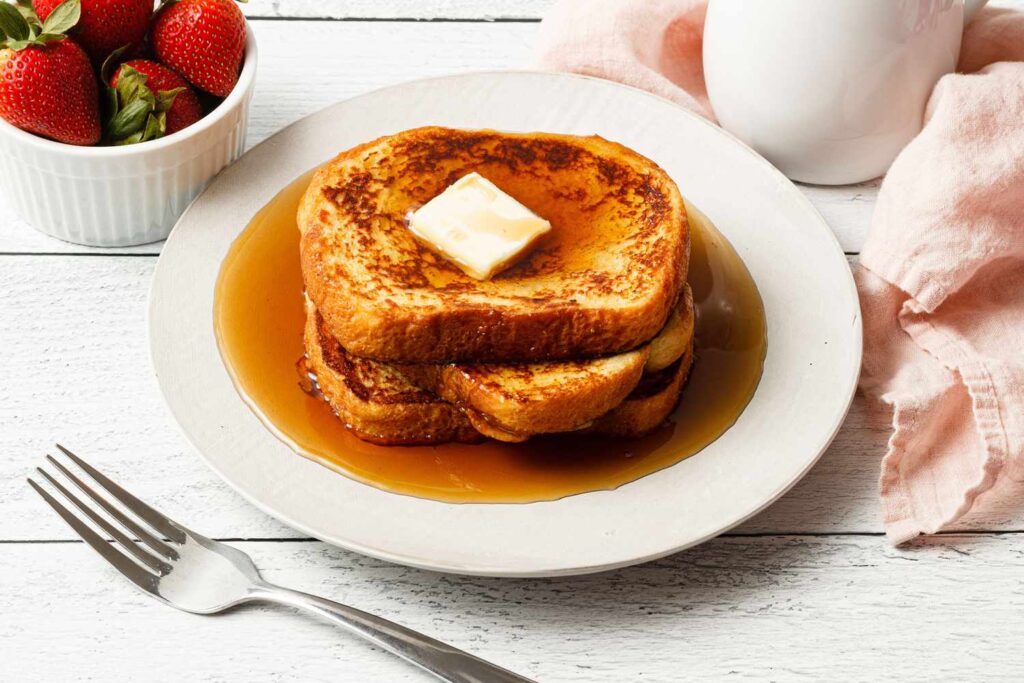French toast has taken on many different forms, from bite-sized pieces to sticks to casseroles, but in our opinion, nothing beats the original. This classic French toast recipe produces slice after slice that’s golden brown on the outside and fluffy and tender inside. We call it white bread, but you can use almost any kind of bread for French toast; it’ll all be delicious.
This French toast recipe has been tested over and over to ensure every texture and flavor is perfect: slightly sweet, fluffy and indulgent.
Learn how to make French toast to create a treat you can have anytime for a weekend or holiday breakfast.
Jessica Furniss
Where did French toast originate from?
Contrary to what the name might suggest, French toast isn’t strictly French: Its origins lie in ancient Rome, where stale bread was soaked in a mixture of milk and eggs to make a dish called pan dulcis.
The name “French toast” first appeared in England when a man named Joseph French coined the term in 1724. The idea of eliminating waste in the kitchen is not new and is still practiced today.
What bread should I use for French toast?
This comes down to preference: some people prefer only thicker breads like sourdough, brioche, or challah for their French toast recipes. These types of bread are good because they are sturdy and will hold up well when soaked in custard.
But for classic French toast like your grandma used to make, we recommend plain white bread. Grandmas loved to stop by the day-old bread store to buy bread that was a little past its expiration date, but there’s a simple trick to get similar results: just lay out the bread slices 10 minutes before you start making the French toast. This way, the outside of the bread will get a little stale, but the inside will remain fresh and fluffy.
Jessica Furniss
Ingredients for French Toast
While no one makes French toast exactly the same way, below are the ingredients most commonly used.
Bread: As mentioned above, slightly stale white bread is perfect for classic French toast. Having a little crust allows the bread to soak up all the custard. However, you can also use thicker, crustier breads such as sourdough, brioche, or challah. Different types of bread will require different lengths of soaking in the custard to ensure that it absorbs the egg mixture without becoming soggy. Eggs: Classic French toast cannot be made without eggs. An egg-free recipe may still taste great, but it won’t have the texture or fluffiness you’re looking for. Milk: This recipe uses whole milk, but any type of milk will do. You can also use heavy cream, half-and-half, or non-dairy milk. Remember, the higher the fat content, the creamier your toast will be. Salt: Adding a little good quality kosher salt to the custard will help bring out the flavor of a well-balanced French toast. If you use table salt, reduce the amount by half to avoid it being too salty. Butter: While some French toast recipes call for margarine or vegetable oil, using real unsalted butter produces the richest, tastiest French toast. If your pan is too hot, the butter has a tendency to become smoky, so make sure it’s the right temperature. If it is smoking, turn the heat down.
How to make French toast
It’s a classic dish for a reason: French toast is one of the easiest recipes to make, yet still incredibly impressive. All you need to make the perfect French toast is six ingredients, a frying pan, and less than 20 minutes.
Make the custard: In a shallow dish or wide bowl, combine the eggs, milk, sugar, salt, and vanilla extract (optional). Whisk until well combined. Dip the bread slices into the custard: Dip the bread slices into the custard for a few seconds, then turn them over to dip the other side. Cook the French toast: Heat a skillet over medium-high heat and melt the butter. Add the custard-soaked bread slices and cook for 1-2 minutes until golden brown. Finish: Flip each slice and cook for an additional 1-2 minutes until golden brown. Top with butter and syrup or your favorite toppings.
Jessica Furniss
How to store French toast
For best results, Classic French Toast should be eaten immediately, but sometimes you may end up with leftovers.
French toast can be stored in a zip-top bag in the refrigerator for 1-2 days and then reheated in the microwave or oven. The texture of the toast may be a little thinner, but it’s still very tasty.
Can I freeze French toast?
Yes, you can freeze your French toast for up to 3 months after making it. It’s perfect for making a weeknight breakfast or stocking up on the perfect brunch dish. Place the baked French toast slices on a baking sheet and freeze for about 3 hours (you can also freeze it overnight).
Transfer the frozen French toast slices to an airtight container or freezer bag, label and store in the freezer for up to 3 months. When you want to eat the French toast, transfer the slices to a baking sheet and warm in the oven at 375°F for about 10 minutes.
Tips for making the best French toast
Our recipe will make delicious French toast, but if you want to make the best French toast ever, these tips will help you.
Add a splash of vanilla to the egg mixture for extra flavor. For fluffy French toast, beat the egg mixture until light in color. Eggs that are not well mixed may end up fried in a toast crust. For a richer, more caramel-like flavor, substitute brown sugar. If the butter continues to burn even over medium heat, add a bit of vegetable oil. This will raise the smoke point and keep the butter from burning.
Source link


